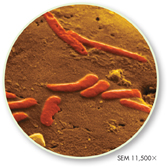 d
d
FIGURE 19–16 Origin of RNA and DNA The “RNA world” hypothesis about the origin of life suggests that RNA evolved before DNA. Scientists have not yet demonstrated the later stages of this process in a laboratory setting. Interpret Visuals How would RNA have stored genetic information?
Scientists haven't solved this puzzle, but molecular biologists have generated intriguing hypotheses. A number of experiments that simulated conditions on early Earth suggest that small sequences of RNA could have formed from simpler molecules. Why is that interesting? It is interesting because we now know that, under the right conditions, some RNA sequences help DNA replicate. Other RNA sequences process messenger RNA after transcription. Still other RNA sequences catalyze chemical reactions, and some RNA molecules even grow and replicate on their own.  The “RNA world” hypothesis proposes that RNA existed by itself before DNA. From this simple RNA-based system, several steps could have led to DNA-directed protein synthesis. This hypothesis, shown in Figure 19–16, is still being tested.
The “RNA world” hypothesis proposes that RNA existed by itself before DNA. From this simple RNA-based system, several steps could have led to DNA-directed protein synthesis. This hypothesis, shown in Figure 19–16, is still being tested.
Production of Free Oxygen Microscopic fossils, or microfossils, of prokaryotes that resemble bacteria have been found in Archean rocks more than 3.5 billion years old. Those first life forms evolved in the absence of oxygen because at that time Earth's atmosphere contained very little of that highly reactive gas.
During the early Proterozoic Eon, photosynthetic bacteria became common. By 2.2 billion years ago, these organisms were churning out oxygen. At first, the oxygen combined with iron in the oceans, producing iron oxide, or rust. Iron oxide, which is not soluble in water, sank to the ocean floor, forming great bands of iron that are the source of most iron ore mined today. Without iron, the oceans changed color from brown to blue-green.
Next, oxygen gas began to accumulate in the atmosphere. The ozone layer began to form, and the skies turned their present shade of blue. Over several hundred million years, oxygen concentrations rose until they reached today's levels. In a sense, this increase in oxygen created the first global “pollution” crisis. To the first cells, which evolved in the absence of oxygen, this reactive gas was a deadly poison! The rise of oxygen in the atmosphere drove some early life forms to extinction. Some organisms, however, evolved new metabolic pathways that used oxygen for respiration. These organisms also evolved ways to protect themselves from oxygen's powerful reactive abilities.

FIGURE 19–17 Fossilized Bacteria Fossilized bacteria are the earliest evidence of life on Earth. These rod-shaped bacterial cells (red) are seen calcified on the shell of a single-celled protozoan.
Table of Contents
- Formulas and Equations
- Applying Formulas and Equations
- Mean, Median, and Mode
- Estimation
- Using Measurements in Calculations
- Effects of Measurement Errors
- Accuracy
- Precision
- Comparing Accuracy and Precision
- Significant Figures
- Calculating With Significant Figures
- Scientific Notation
- Calculating With Scientific Notation
- Dimensional Analysis
- Applying Dimensional Analysis




